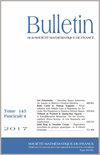Nouveaux théorèmes d’isogénie
IF 0.6
4区 数学
Q3 MATHEMATICS
引用次数: 5
Abstract
— Given a finitely generated field extension K of the rational numbers and an abelian variety C over K, we consider the class of all abelian varieties over K which are isogenous (over K) to an abelian subvariety of a power of C. We show that there is a single, naturally constructed abelian variety C in the class whose ring of endomorphisms controls all isogenies in the class. Precisely, this means that if d is the discriminant of this ring then for any pair of isogenous abelian varieties in the class there exists an isogeny between them whose kernel has exponent at most d. Furthermore we prove that, for any element A in the class, the same number d governs several invariants attached to A such as the smallest degree of a polarisation on A, the discriminant of its ring of endomorphisms or the size of the invariant part of its geometric Brauer group. All these are bounded only in terms of d and the dimension of A. In the case where K is a number field we can go further and show that the period theorem applies to C in a natural way and gives an explicit bound for d in terms of the degree of K, the dimension of C and the stable Faltings height of C. This in turn yields explicit upper bounds for all the previous quantities related to isogenies, polarisations, endomorphisms, Brauer groups which significantly improve known results. MSC 2020 : 11G10 (14K02, 11R54, 14K15). Mots-clefs : variété abélienne, isogénie, ordre maximal, ordre principal, anneau de Lefschetz, module de Tate, polarisation, groupe de Brauer, réseau des périodes, théorème des périodes.新的等等定理
本文章由计算机程序翻译,如有差异,请以英文原文为准。
求助全文
约1分钟内获得全文
求助全文
来源期刊
CiteScore
0.90
自引率
0.00%
发文量
0
审稿时长
>12 weeks
期刊介绍:
The Bulletin de la Société Mathématique de France was founded in 1873, and it has published works by some of the most prestigious mathematicians, including for example H. Poincaré, E. Borel, E. Cartan, A. Grothendieck and J. Leray. It continues to be a journal of the highest mathematical quality, using a rigorous refereeing process, as well as a discerning selection procedure. Its editorial board members have diverse specializations in mathematics, ensuring that articles in all areas of mathematics are considered. Promising work by young authors is encouraged.

 求助内容:
求助内容: 应助结果提醒方式:
应助结果提醒方式:


